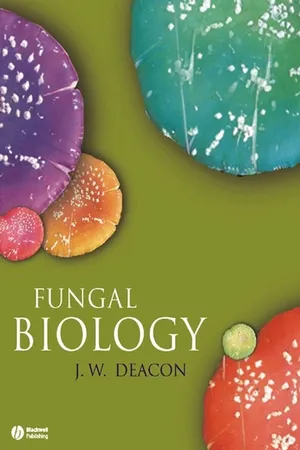Bacterial Endospores
Bacterial endospores are dormant, highly resistant structures formed by certain species of bacteria as a survival mechanism in response to harsh environmental conditions. They are composed of a tough, protective coat that shields the bacterial DNA and other essential molecules. Endospores can remain viable for long periods and are notoriously difficult to eradicate, making them a significant concern in various industries and healthcare settings.
3 Key excerpts on "Bacterial Endospores"
- eBook - ePub
- Lynne McLandsborough(Author)
- 2017(Publication Date)
- CRC Press(Publisher)
...Laboratory 13 Enumeration of Spores from Pepper I. Objective Learn the basics of performing a general spore count. II. Background Certain types of bacteria produce spores in response to environmental stresses. In general, bacterial spores are dormant forms of cells that are much more resistant to heat, dehydration, freezing, and irradiation than the vegetative forms of the cells. In food processing, these increased resistances are of concern for food spoilage and food safety reasons. Spores are associated in nature with soil, dust, and water. Some spore-forming organisms such as Clostridium perfringens are also associated with the intestinal tracts of humans and animals. Because spores have a high resistance to desiccation, it is not surprising that spores are detected in many foods containing dehydrated ingredients, such as starches, vegetables, grains, and spices. Spore-forming bacteria are mainly from two genera of Gram-positive bacteria: Clostridium and Bacillus. Members of the Clostridium genus are strict (i.e., will only grow anaerobic) or facultative (prefers to grow in anaerobic) anaerobes. The members of the Bacillus genera tend to be aerobes or facultative anaerobes, and most produce the enzyme catalase. Spore-forming bacteria can also be divided by optimal growth temperature. There are both mesophilic and thermophilic spore-forming bacteria. The heat resistance of spores can vary. In any processed food, the intrinsic heat resistance of the spore, along with the pH, atmosphere, and processing and postprocessing holding temperatures, will determine which spores will germinate and grow. Spices are produced all over the world and are notorious for having high populations of bacteria (both vegetative and spores), yeasts, and molds. The microbial populations of spices are probably mainly residents on the plant that survived drying and storage...
- eBook - ePub
- J. W. Deacon(Author)
- 2013(Publication Date)
- Wiley-Blackwell(Publisher)
...60°C for 20–30 minutes), cold shock (−3°C), or exposure to chemicals such as alcohols or furaldehyde. The ascospores of Neurospora tetrasperma have been studied most thoroughly in this respect. Their dormancy cannot be explained in terms of a general permeability barrier, because they are permeable to radiolabeled oxygen, glucose, and water. Instead, their dormancy is linked to an inability to use their major storage reserve, trehalose, which is not metabolized during dormancy, but is metabolized immediately after activation. The enzyme trehalase, which cleaves trehalose to glucose, is found to be associated with the walls of the dormant spores, separated from its substrate. Activation somehow causes the enzyme to enter the cell, as one of the earliest detectable events in germination. Fig. 10.2 A developing sexual spore (oospore) of Pythium mycoparasiticum (Oomycota). The spore has a very thick wall (w) and is contained in the outer wall (ow) of the oogonium (female reproductive cell). The arrows mark the positions of antheridia (male sex organs that fertilize the oogonium). Constitutive dormancy of some other spores has been linked to endogenous inhibitors. For example, uredospores of the cereal rust fungus Puccinia graminis contain methyl- cis -ferulate, and those of bean rust, Uromyces phaseoli, contain methyl- cis -3,4-dimethoxycinnamate. Prolonged washing of spores can remove these inhibitors, and this perhaps occurs when the spores are bathed in a water film on a plant surface. At first sight it seems surprising that a spore adapted for dispersal should have an endogenous inhibitor. However, this might prevent the spores from germinating in a sporing pustule (they do not require exogenous nutrients for germination) and ensure that they germinate only after they have been dispersed. Ecological aspects of constitutive dormancy The behavior of constitutively dormant spores often has clear ecological relevance...
- eBook - ePub
- Vincent A. Fischetti, Richard P. Novick, Joseph J. Ferretti, Daniel A. Portnoy, Mirian Braunstein, Julian I. Rood, Vincent A. Fischetti, Richard P. Novick, Joseph J. Ferretti, Daniel A. Portnoy, Mirian Braunstein, Julian I. Rood(Authors)
- 2019(Publication Date)
- ASM Press(Publisher)
...Even in cases of botulism intoxication, the spore form is critical for contaminating food, where incomplete sterilization or processing, such as during home canning, can create anaerobic environments that allow C. botulinum spores to germinate and form toxin-producing vegetative cells that subsequently intoxicate the food (17). C. difficile C. difficile is a leading cause of antibiotic-associated diarrhea and pseudomembranous colitis worldwide (18, 19). C. difficile -associated disease occurs when spores, ingested by susceptible hosts, germinate in response to specific bile acids sensed in the mammalian gut; the resulting vegetative cells produced secrete glucosylating toxins that are the primary cause of disease symptoms (20). Notably, antibiotic exposure sensitizes individuals to antibiotic-resistant C. difficile by removing the colonization resistance conferred by our gut microflora (21). Spores are critical to this infection process not only because they are essential for transmitting C. difficile infections (6) but also because they are inert to antibiotics and resist many commonly used disinfectants in health care settings (22, 23). Accordingly, spores are easily detected in health care-associated environments (24) in addition to numerous other sites (8). OVERVIEW OF SPORE FORMATION The first morphological stage of sporulation is the formation of a polar septum, which generates two morphologically distinct, but genetically identical, cells (Fig. 1) (25). The larger mother cell engulfs the smaller forespore cell, leaving the forespore within the mother cell cytosol surrounded by two membranes. A thick layer of modified peptidoglycan known as the cortex forms between the two membranes, conferring spores with heat and ethanol resistance (26, 27). A series of proteinaceous layers known as the coat assembles around the outer forespore membrane and protects the spore against enzymatic and oxidative insults. In C...


